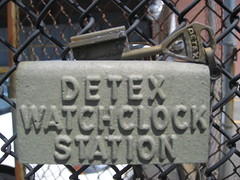From Christopher Fahey’s “Who Watches the Watchman?” (GraphPaper: 2 May 2009):
The Detex Newman watchclock was first introduced in 1927 and is still in wide use today.
&hellip What could you possibly do in 1900 to be absolutely sure a night watchman was making his full patrol?
An elegant solution, designed and patented in 1901 by the German engineer A.A. Newman, is called the “watchclock”. It’s an ingenious mechanical device, slung over the shoulder like a canteen and powered by a simple wind-up spring mechanism. It precisely tracks and records a night watchman’s position in both space and time for the duration of every evening. It also generates a detailed, permanent, and verifiable record of each night’s patrol.
What’s so interesting to me about the watchclock is that it’s an early example of interaction design used to explicitly control user behavior. The “user” of the watchclock device is obliged to behave in a strictly delimited fashion.
…
The key, literally, to the watchclock system is that the watchman is required to “clock in” at a series of perhaps a dozen or more checkpoints throughout the premises. Positioned at each checkpoint is a unique, coded key nestled in a little steel box and secured by a small chain. Each keybox is permanently and discreetly installed in strategically-placed nooks and crannies throughout the building, for example in a broom closet or behind a stairway.
The watchman makes his patrol. He visits every checkpoint and clicks each unique key into the watchclock. Within the device, the clockwork marks the exact time and key-location code to a paper disk or strip. If the watchman visits all checkpoints in order, they will have completed their required patrol route.
The watchman’s supervisor can subsequently unlock the device itself (the watchman himself cannot open the watchclock) and review the paper records to confirm if the watchman was or was not doing their job.
